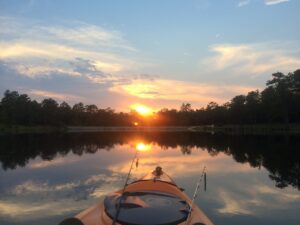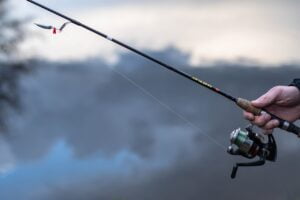
Wanna change your bass fishing experience? Switching from a powerful boat to a kayak will be an excellent idea. Kayaking saves money while allowing you to fish in silence as you kayak to shallow and standing water without scaring your prey.
I often pull my kayak into the weeds right on the water’s edge. Anchoring the boat with a mud anchor can also prevent it from swaying. But these tips are just a tiny part of the journey. Here are some practical and effective tricks for bass fishing from a kayak. Let’s jump into the details!
Check The Weather Condition
With the ideal weather, your fishing trip will become much easier. Here is something you want to check about it before heading for the water.
Barometric pressure
Barometric pressure is essential for bass fishing, whether kayaking or boating. It will affect the fish’s behavior and then your chances of catching them.
Barometric pressure refers to the atmosphere’s weight on the earth’s surface. The pressure ranging from 29.6 to 30.5 millibars is the best for bass fishing from a kayak.
If the pressure is rising, you will notice calm winds and bluebird skies. Under such conditions, the bass swim to deeper waters. Hence, try kayaking to ledges, drop-offs, or channels to catch them.
Moreover, the high barometric pressure makes the bass less active. To attract them, you need to present your lures and jigs slowly. Downsizing the baits can also work.
On the other hand, if the barometric pressure is falling, you can catch bass from your kayak in shallower water and areas with cover, like fallen trees and weeds.
When the pressure decreases, the bass become more active. So don’t hesitate to use present fast lures. Crankbaits and spinnerbaits come in handy in these cases.
Temperature
The ideal temperature for bass fishing from a kayak is 74 to 79°F when these fish feed aggressively.
If the water temperature rises above 80°F, the bass slow their activities and become nocturnal. Meanwhile, under 40°F, they move to the deepest waters to find shelter and don’t want to follow your lures.
Weather
While the rain may give you a hard time kayaking, you will catch more big bass. On a rainy day, water becomes more oxygenated, encouraging the bass to feed actively.
The best bet for a bass fishing trip is gentle rain with clouds. It would be best to cast your line before the rain when the humidity level is the highest.
Choose A Kayak For Bass
While a large kayak makes you feel comfortable, it may catch the wind and be misdirected by the currents. The rocks and concrete won’t damage your durable kayak but will still affect your trip.
As you can see, choosing the right kayak for bass fishing is not easy. So how to pick up the best one?
Consider the type of your kayak

A sit-on-top kayak is better for your fishing trip than a sit-in model because it gives you more stability and maneuverability.
Sit-on-top kayaks are wider. Hence, you won’t have to worry about tipping over when casting your line or reeling your trophy fish.
Moreover, sit-on-top kayaks have more storage space, allowing you to carry more fishing gear and tackle boxes. Some models have compartments designed for fishing.
Peddle kayaks are a good idea, too. They provide more power for maneuvering across strong currents and greater distances than paddle strokes.
Moreover, peddle kayaks are easier to turn. Using these boats, you won’t be concerned about oars preventing you from fighting against the fish. You can strap oars behind just in case you want to use them.
Choose a kayak you can stand up in
If possible, choose a sit-on-top kayak that you can stand up on while fishing. The standing position is better for catching bass.
Standing up gives you a strong vantage point for casting, so you can cast longer distances, which is useful for targeting bass in open water.
In addition, standing on your kayak helps you move around easily and explore different areas. If you want to cover a lot of water when fishing bass, you will prefer standing during your trip.
Do not overload your kayak
Your kayak can be spacious but can’t hold all your stuff. So decide which equipment you really need for your trip after considering the weather and your fishing style. Often, two rods and one tackle are enough.
If your kayak carries too many things, the excess weight will reduce its stability. Overloading also makes it difficult to maneuver.
Google Maps And Google Earth Or Sonar

Google Maps helps us see your location on the map using GPS (Global Positioning System) by providing information on places. Meanwhile, Google Earth allows us to explore geography and see satellite images. Both apps are powerful tools for anglers while fishing from a kayak. So how can you use these apps?
Find the fishing spots
Google Earth can help identify potential fishing spots, such as weed beds or shallow covers where the bass gather. Then, you just need to follow the route to access them.
Please note that traveling on the water is trickier than on the ground. But fear not because you can use Google Earth to plan your route properly.
You can also use Google Maps for the same purpose. I usually start with its default map view to find water. Then, I switch to the satellite view and zoom in to see the area clearly.
Another brilliant tool from these apps is that you can quickly pin placemarks and paths to the maps to identify the fishing locations. Then, designate the potential spots that have brought big bass in the past.
Measure the distances
The distance tool of Google Earth and Google Maps is a nifty feature to estimate distances to the targeted fishing habitats. You can alter the scale to suit your specific requirement and use it to gauge the distance to the fishing spot.
Rigging For Bass On Kayak
Carolina, Texas, and Neko rigs are the best for fishing bass from a kayak. Which one should you choose?
Carolina rig
You need a bullet weight, swivel, bead, hook, leader line, and worm to set up this rig. It’s one of the most popular rigs for bass fishing.
This rig is best before and after the spawning period. During this time, you can find bass in depths of up to 15 feet. That’s why you need this bottom rig.
Texas rig
Texas rigs are also common among anglers when it comes to bass fishing. You may love them if you like to fish in riskier areas where large bass hide.
A Texas rig consists of a micro swivel, leader line, bullet weight, buffer bed, offset hook, and plastic bait. You can use it weightless or attach a sinker to it.
Neko rig

The Neko rig is a versatile rigging type that works well in clear and stained water. You can also use it year-round to reel in big fish.
Setting up the rig is straightforward. You just need a nail weight, drop-shot hook, wacky ring, and Neko fat form.
You can find all types of bass rigs here. Feel free to experiment with them so you can determine your favorite.
Safety Precautions For Bass Fishing From Kayak

Bass fishing from a kayak must be fun. Yet, nothing is more important than your safety. Here are some precautions to take during your trip:
- Wear PFD (Personal Flotation Device) while kayaking, whether you can swim or not.
- Although fishing bass on rainy days can yield an impressive result, be careful with strong winds and thunderstorms.
- Bring a cell phone or something you use to communicate with your friends for help in an emergency. You may be busy immersing yourself in your adventure and getting lost.
- Leave some space in the storage compartment for water. You should stay hydrated, especially on sunny days.
- It would be best to fish with other kayakers so you can help each other.
- Do not access water that is more than eight feet deep alone.
- Ensure your kayaking skills are good enough to handle the fish and stay balanced on the boat.
Conclusion
Bass fishing from a kayak gives you a unique and rewarding experience. It helps you access hard-to-reach areas and offers a chance to enjoy the new views of nature.
Yet, fishing and kayaking at the same time is challenging. So, prepare your gear properly. Also, keep the safety precautions in mind.
So what are you waiting for? Grab your gear, hop on your kayak, and start your adventure!

